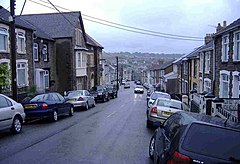Bargoed
Bargoed
|
|
|---|---|
 |
|
| Bargoed shown within Caerphilly | |
| Population | 11,900 (2011) |
| OS grid reference | ST145995 |
| Principal area | |
| Ceremonial county | |
| Country | Wales |
| Sovereign state | United Kingdom |
| Post town | BARGOED |
| Postcode district | CF81 |
| Dialling code | 01443 |
| Police | Gwent |
| Fire | South Wales |
| Ambulance | Welsh |
| EU Parliament | Wales |
| UK Parliament | |
Bargoed (Welsh: Bargod) is a town in the Rhymney Valley, Wales, one of the South Wales Valleys. It lies on the Rhymney River in the county borough of Caerphilly and straddles the ancient boundary of Glamorgan and Monmouthshire, with Bargoed originally lying within the old county of Glamorganshire whereas Aberbargoed was in the old county of Monmouthshire. 'Greater Bargoed', as defined by the local authority Caerphilly County Borough Council, consists of the towns of Bargoed, Aberbargoed and the village of Gilfach. The combined population of these settlements is approximately 13,000.
The English meaning of the town's Welsh language name, Bargod, is border. Pronunciation of the town's name varies depending on street. There are many variations, from the standard Welsh Barr-god and English Bar-goyd to the informal Baa-Gud and Baa-Go-Ed.
Originally a market town, Bargoed grew into a substantial town following the opening of a colliery in 1903. By 1921 Bargoed had a population of 17,901; this has been steadily declining since that time, as the general demand for Welsh coal continued to fall. The colliery, which was the subject of a painting by L. S. Lowry, closed during the 1980s, and its former site is now a country park.
An electoral ward with the same name exists. At the 2011 census this ward had a population of 6,196.
...
Wikipedia

